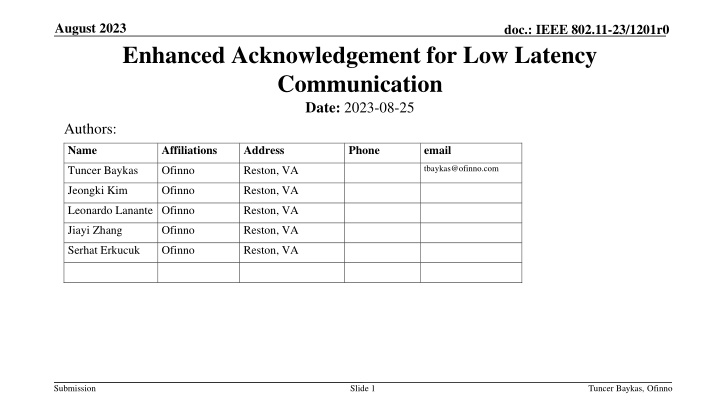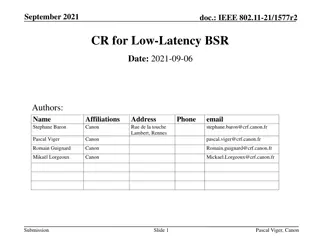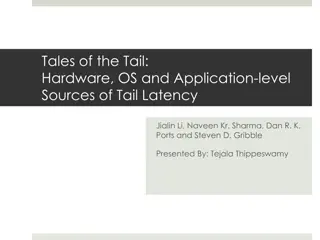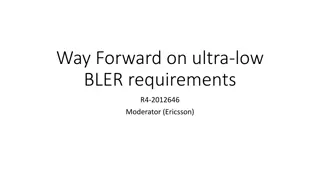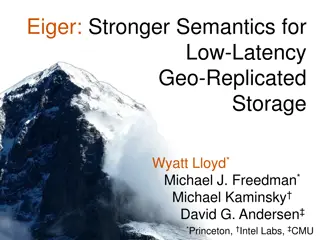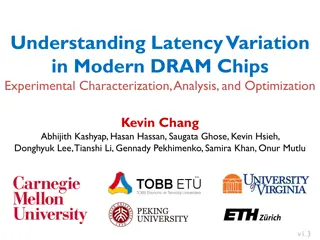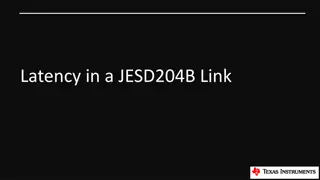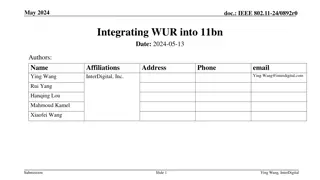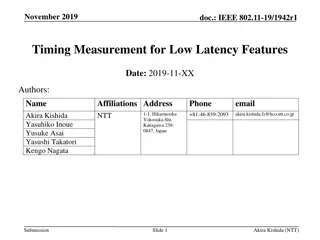Enhanced Acknowledgement for Low Latency Communication
In this presentation, an enhanced acknowledgement method is proposed to reduce delays in lower latency traffic transmission within the IEEE 802.11 standard. The focus is on early acknowledgement of low latency packets to enhance reliability and support lower latency requirements.
Download Presentation

Please find below an Image/Link to download the presentation.
The content on the website is provided AS IS for your information and personal use only. It may not be sold, licensed, or shared on other websites without obtaining consent from the author.If you encounter any issues during the download, it is possible that the publisher has removed the file from their server.
You are allowed to download the files provided on this website for personal or commercial use, subject to the condition that they are used lawfully. All files are the property of their respective owners.
The content on the website is provided AS IS for your information and personal use only. It may not be sold, licensed, or shared on other websites without obtaining consent from the author.
E N D
Presentation Transcript
August 2023 doc.: IEEE 802.11-23/1201r0 Enhanced Acknowledgement for Low Latency Communication Date: 2023-08-25 Authors: Name Affiliations Address Phone email tbaykas@ofinno.com Tuncer Baykas Ofinno Reston, VA Jeongki Kim Ofinno Reston, VA Leonardo Lanante Ofinno Reston, VA Jiayi Zhang Ofinno Reston, VA Serhat Erkucuk Ofinno Reston, VA Submission Slide 1 Tuncer Baykas, Ofinno
August 2023 doc.: IEEE 802.11-23/1201r0 Abstract In this presentation we present an enhanced acknowledgement method to reduce delay of a lower latency traffic transmission. Tuncer Baykas, Ofinno Submission Slide 2
August 2023 doc.: IEEE 802.11-23/1201r0 Early Acknowledgement of Low Latency Packets Increased reliability and support of lower latency are two of the main improvement areas of the 802.11bn project. An important part of the low latency communication is verifying that the packets arrive correctly. With multi link communication and simultaneous transmit and receive (STR) capability, we need to allow to acknowledge MSDUs or A-MSDUs with low latency requirement before the end of the PPDU transmission. Tuncer Baykas, Ofinno Submission Slide 3
August 2023 doc.: IEEE 802.11-23/1201r0 Early Acknowledgement of MPDUs Non LL MPDU LL MPDU (n+1)th MPDU PHY Header nth MPDU First Link MLD 1 PSDU Second Link MLD 2 BA First Link Feedback Frame Second Link We assume that transmitter and receiver are multi-link and simultaneous transmit and receive capable. The payload is transmitted from the first link. After the reception of the low latency MPDU, receiver sends a feedback frame to indicate reception status from the second link. Submission Slide 4 Tuncer Baykas, Ofinno
August 2023 doc.: IEEE 802.11-23/1201r0 Retransmission Option 1 If the feedback frame indicates the low latency MPDU is received in error. The second link could be used to transmit the MPDU received in Error. MLD 1 PHY Header nth MPDU First Link PHY Header nth MPDU Second Link MLD 2 First Link Feedback Frame Second Link Submission Slide 5 Tuncer Baykas, Ofinno
August 2023 doc.: IEEE 802.11-23/1201r0 Retransmission Option 2 Another option is adding the MPDU received in error at the end of the PPDU, with dynamic PPDU modification. PHY Header nth MPDU SIG nth MPDU First Link MLD 1 PPDU extension Second Link MLD 2 First Link Feedback Frame Second Link Submission Slide 6 Tuncer Baykas, Ofinno
August 2023 doc.: IEEE 802.11-23/1201r0 Early Indication of SIG Field Errors Feedback frame could be utilized to indicate if there is an error in the PHY Header. PHY Header nth MPDU First Link MLD 1 Second Link MLD 2 First Link Feedback Frame Second Link Submission Slide 7 Tuncer Baykas, Ofinno
August 2023 doc.: IEEE 802.11-23/1201r0 Conclusion In this contribution, we provide a feedback scheme to early indication of error for low latency transmissions. Submission Slide 8 Tuncer Baykas, Ofinno
